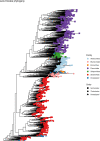Leviviricetes: expanding and restructuring the taxonomy of bacteria-infecting single-stranded RNA viruses
- PMID: 34747690
- PMCID: PMC8743537
- DOI: 10.1099/mgen.0.000686
Leviviricetes: expanding and restructuring the taxonomy of bacteria-infecting single-stranded RNA viruses
Abstract
The vast majority of described prokaryotic viruses have double-stranded or single-stranded DNA or double-stranded RNA genomes. Until 2020, a mere four prokaryotic single-stranded, positive-sense RNA viruses have been classified in two genera (Riboviria; Lenarviricota; Allassoviricetes; Leviviridae). Several recent metagenomic and metatranscriptomic studies revealed a vastly greater diversity of these viruses in prokaryotic soil communities than ever anticipated. Phylogenetic analysis of these newly discovered viruses prompted the reorganization of class Allassoviricetes, now renamed Leviviricetes, to include two orders, Norzivirales and Timlovirales, and a total of six families, 428 genera and 882 species. Here we outline the new taxonomy of Leviviricetes, approved and ratified in 2021 by the International Committee on Taxonomy of Viruses, and describe open-access hidden Markov models to accommodate the anticipated identification and future classification of hundreds, if not thousands, of additional class members into this new taxonomic framework.
Keywords: Leviviricetes; levivirus; metatranscriptomics; phage; virus classification; virus taxonomy.
Conflict of interest statement
The authors declare that there are no conflicts of interest. E.M.A., J.H.K., J.R. and A.N.S. are members of the ICTV.
Figures



References
-
- Callanan J, Stockdale S, Adriaenssens E, Kuhn J, Pallen M, et al. rename one class (leviviricetes - formerly allassoviricetes), rename one order (norzivirales - formerly levivirales), create one new order (timlovirales), and expand the class to a total of six families, 420 genera and 883 species. ICTV TaxoProp 2020.095b. 2021. https://talk.ictvonline.org/files/ictv_official_taxonomy_updates_since_t...
-
- Walker PJ, Siddell SG, Lefkowitz EJ, Mushegian AR, Adriaenssens EM, et al. Changes to virus taxonomy and to the International Code of Virus Classification and Nomenclature ratified by the International Committee on Taxonomy of Viruses (2021. Arch Virol. 2021;166:2633–2648. doi: 10.1007/s00705-021-05156-1. - DOI - PubMed
-
- Wildy P. First report of the International Committee on Nomenclature of viruses. Basel, Switzerland: S. Karger; 1971. Classification and nomenclature of viruses.
-
- Fenner F. Classification and nomenclature of viruses. Second report of the International Committee on Taxonomy of Viruses Intervirology. 1976;7:1–115. - PubMed
Publication types
MeSH terms
Grants and funding
- BB/R012490/1 /BB_/Biotechnology and Biological Sciences Research Council/United Kingdom
- BBS/E/F/000PR10356/BB_/Biotechnology and Biological Sciences Research Council/United Kingdom
- BBS/E/F/000PR10353/BB_/Biotechnology and Biological Sciences Research Council/United Kingdom
- HHSN272201800013C/AI/NIAID NIH HHS/United States
- MR/T030062/1/MRC_/Medical Research Council/United Kingdom
LinkOut - more resources
Full Text Sources

